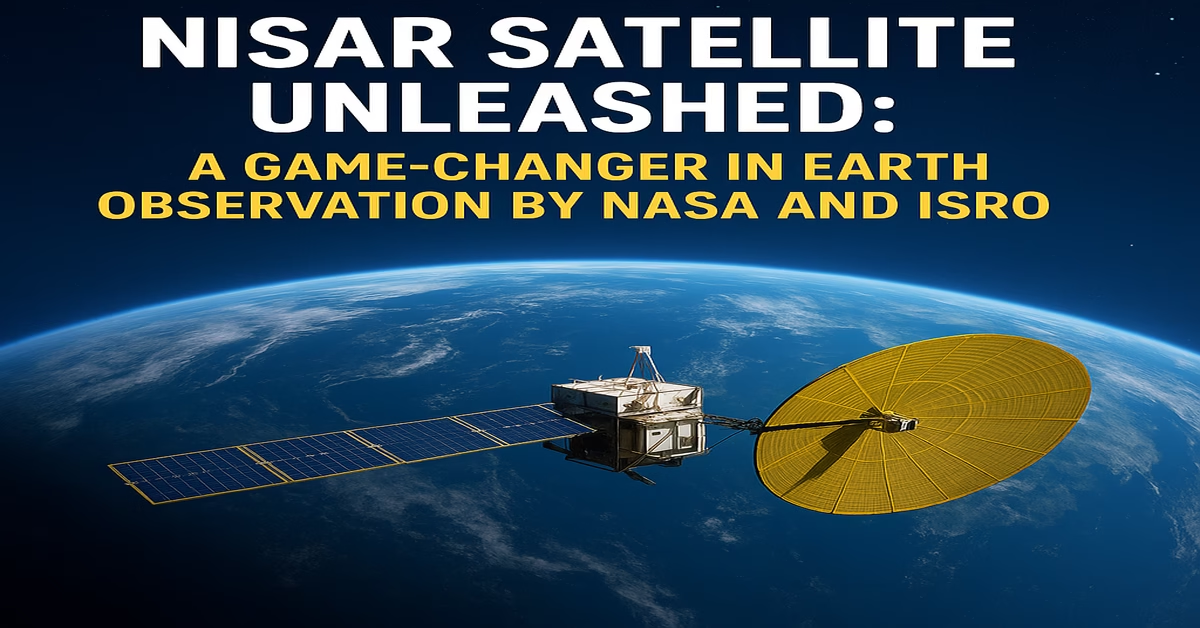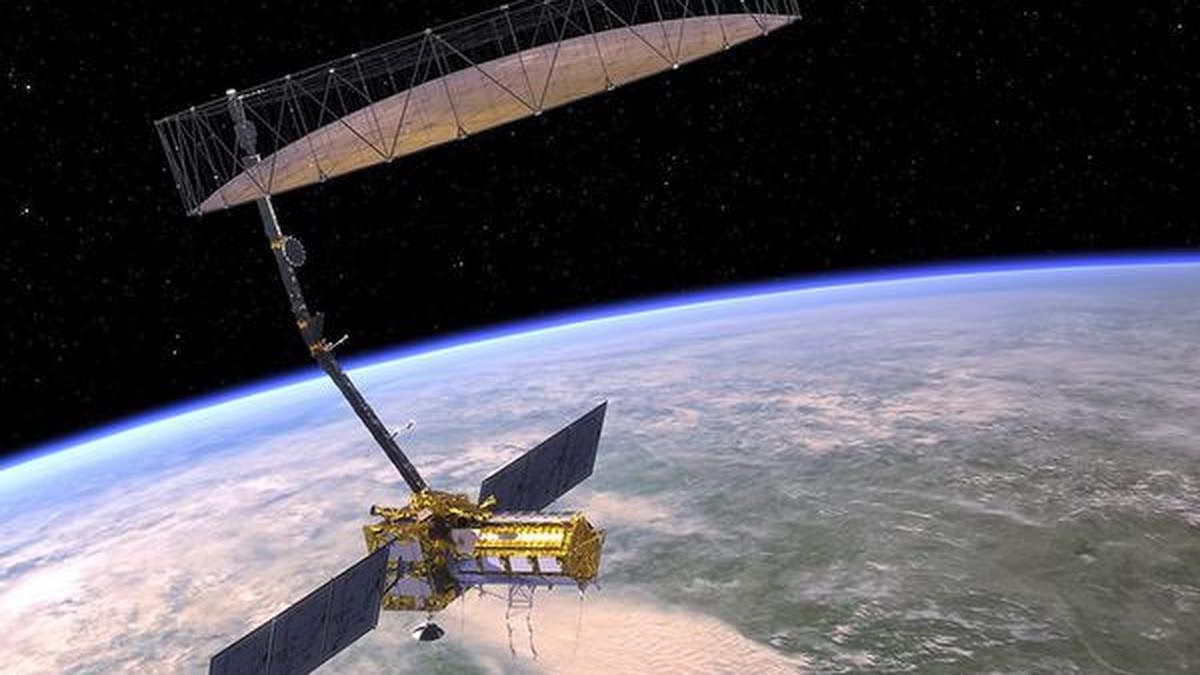
Introduction
The NASA-ISRO Synthetic Aperture Radar (NISAR) satellite, launched on July 30, 2025, represents a landmark achievement in global Earth observation and international space collaboration. A joint mission between the National Aeronautics and Space Administration (NASA) and the Indian Space Research Organisation (ISRO), NISAR is the first satellite to employ dual-frequency synthetic aperture radar (SAR) technology, operating in both L-band and S-band frequencies. This innovative observatory is designed to monitor Earth’s dynamic surfaces, ecosystems, and ice masses with unprecedented precision, offering critical data to address pressing global challenges such as climate change, natural disasters, and resource management. With a mission cost of approximately $1.5 billion, NISAR is poised to be the world’s most expensive Earth-imaging satellite, underscoring its technological sophistication and scientific ambition. This article explores the origins, development, technical specifications, scientific objectives, and societal impacts of the NISAR mission, highlighting its role in advancing our understanding of Earth’s complex systems.
Origins and Development of the NISAR Mission
The NISAR mission traces its roots to a 2007 recommendation from the U.S. National Research Council’s Decadal Survey, which called for a mission to address critical gaps in Earth science data related to deformation, ecosystem structure, and ice dynamics. Initially conceptualized as the Deformation, Ecosystem Structure, and Dynamics of Ice (DESDynI) mission, the project evolved over time, culminating in a partnership with ISRO in 2014. This collaboration marked the first time NASA and ISRO cooperated on hardware development for an Earth-observing mission, leveraging the strengths of both agencies to create a cutting-edge satellite.
Under the terms of the agreement, NASA, through its Jet Propulsion Laboratory (JPL), provided the L-band SAR (1.25 GHz, 24 cm wavelength), a high-rate telecommunication subsystem, GPS receivers, a solid-state recorder, and a payload data subsystem. ISRO contributed the S-band SAR (3.20 GHz, 9.3 cm wavelength), the satellite bus, the Geosynchronous Satellite Launch Vehicle (GSLV) Mark II, and launch services. The partnership also included a shared 12-meter deployable mesh antenna, a critical component for achieving high-resolution imaging over a wide swath.
The development process was meticulous, spanning over a decade. The satellite was fully integrated by January 2024 at ISRO’s U R Rao Satellite Centre (URSC) in Bengaluru, followed by extensive testing to ensure its readiness for the harsh conditions of space. A significant milestone occurred on October 15, 2024, when NASA’s C-130 aircraft transported the satellite from Wallops Flight Facility in Virginia to Bengaluru, India, via a multi-leg journey. By May 2025, NISAR was transported to the Satish Dhawan Space Centre (SDSC) in Sriharikota, where it was prepared for launch aboard the GSLV-F16 on July 30, 2025, at 5:40 PM IST.
Despite initial delays—originally scheduled for March 2024, the launch was postponed due to hardware upgrades and additional testing—the mission proceeded smoothly, with the satellite successfully injected into a 743 km Sun-synchronous orbit (SSO) with a 98.4° inclination. This dawn-to-dusk orbit ensures optimal solar power generation and consistent imaging conditions.
Technical Specifications and Innovations
NISAR’s technological prowess lies in its dual-frequency SAR system, which combines L-band and S-band radars to achieve high-resolution imaging with a wide swath. The satellite employs the SweepSAR technique, a novel approach that allows it to cover a 242 km swath with spatial resolutions ranging from 2 to 8 meters cross-track and 7 meters along-track. This capability enables NISAR to map the entire globe every 12 days, providing spatially and temporally consistent data.
Key Components
- L-band SAR (NASA): Operating at 1.25 GHz with a 24 cm wavelength, the L-band radar penetrates thicker vegetation and ice, making it ideal for monitoring forested areas, landscape topography, and ice sheets. It is particularly suited for studying the Antarctic cryosphere, as its left-facing instruments are optimized for polar observations.
- S-band SAR (ISRO): Operating at 3.20 GHz with a 9.3 cm wavelength, the S-band radar is less affected by ionospheric disturbances, making it effective for monitoring soil moisture, particularly in polar regions. It complements the L-band by providing data on less vegetated areas and surface features.
- 12-Meter Deployable Antenna: The gold-plated wire mesh antenna, shared by both radars, focuses radar signals to achieve high-resolution imaging. Supported by a deployable boom and attached to the Radar Instrument Structure (RIS), it is a critical component of the observatory.
- Spacecraft Bus (ISRO): The modified I3K satellite bus provides structural support, power, and thermal control. Equipped with two solar arrays generating approximately 4 kW of power, the bus ensures the satellite’s operational stability.
- Engineering Payload (NASA): Includes a high-rate communication subsystem for science data, GPS receivers for precise orbit determination, and a solid-state recorder for data storage. These components ensure efficient data handling and transmission.
Synthetic Aperture Radar (SAR) Technology
SAR technology is central to NISAR’s mission. Unlike optical sensors, SAR uses microwave signals to create high-resolution images, enabling observations through clouds, darkness, and dense vegetation. By emitting radar pulses and measuring their reflections, SAR produces detailed maps of surface changes with precision down to fractions of a centimeter. The dual-frequency approach enhances this capability, allowing NISAR to capture both broad-scale and fine-scale changes.
The SweepSAR technique further distinguishes NISAR. By electronically steering the radar beam, it achieves a wide swath without sacrificing resolution, a significant advancement over previous SAR missions. This enables comprehensive monitoring of Earth’s land and ice-covered surfaces, from glaciers to fault lines.
Scientific Objectives
NISAR’s primary mission is to measure Earth’s changing ecosystems, dynamic surfaces, and ice masses, providing data on biomass, natural hazards, sea level rise, groundwater, and climate change. Its objectives align with three core Earth science domains: deformation, ecosystem structure, and ice dynamics.
1. Deformation: Monitoring Earth’s Crust
NISAR’s ability to detect surface movements as small as a centimeter makes it a powerful tool for studying tectonic activity. By mapping fault lines, it can identify areas prone to earthquakes, particularly in seismically active regions like the Himalayas. While it cannot predict earthquakes, NISAR’s data helps scientists understand fault mechanics, distinguishing between slow-moving and locked fault segments. This information is critical for assessing seismic risks and improving disaster preparedness.
For volcanic activity, NISAR tracks ground deformation to detect magma movement, aiding in eruption forecasting. It also monitors landslides, identifying early signs of instability to support timely evacuations.
2. Ecosystem Structure: Tracking Vegetation and Biomass
NISAR’s L-band radar penetrates forest canopies to measure vegetation biomass, providing insights into carbon storage and deforestation. By monitoring forests, wetlands, and farmlands, it supports sustainable resource management and informs climate models. The satellite’s data also aids in assessing ecosystem disturbances, such as wildfires and habitat loss, which are critical for biodiversity conservation.
3. Ice Dynamics: Studying Glaciers and Ice Sheets
NISAR’s observations of ice sheets, glaciers, and sea ice are vital for understanding climate change impacts. Its L-band radar tracks ice flow rates and retreat, particularly in Antarctica and Greenland, where ice loss contributes to sea level rise. By mapping ice-covered surfaces every 12 days, NISAR provides a comprehensive view of cryospheric changes, supporting predictions of future sea level trends.
Additional Applications
Beyond its core objectives, NISAR supports a range of applications:
- Disaster Management: Rapid data delivery (within hours for emergencies) enables faster response to earthquakes, tsunamis, and volcanic eruptions.
- Agriculture: Data on soil moisture, crop growth, and land-use changes enhance food security and farming practices.
- Infrastructure Monitoring: NISAR assesses the stability of dams, levees, and urban areas, detecting subsidence and oil spills.
- Sea Level Rise and Groundwater: By mapping coastal elevations and aquifer changes, NISAR informs water resource management.
Societal and Scientific Impacts
NISAR’s data is freely available to the global scientific community and public, typically within one to two days of observation, promoting transparency and collaboration. This open-access policy, aligned with NASA’s data-sharing principles, ensures that researchers, policymakers, and disaster response teams worldwide can leverage NISAR’s insights.
Advancing Climate Science
NISAR’s high-resolution data enhances climate models by providing detailed measurements of ice loss, carbon storage, and surface changes. Its ability to monitor sea level rise and glacier retreat informs adaptation strategies for coastal communities. By quantifying ecosystem changes, NISAR supports efforts to mitigate climate impacts and preserve biodiversity.
Enhancing Disaster Preparedness
The satellite’s continuous monitoring of natural hazards revolutionizes disaster management. In regions with limited ground-based monitoring, such as remote parts of the Himalayas, NISAR’s data identifies high-risk areas, enabling proactive measures. Its role in post-disaster analysis, such as mapping fault movement after earthquakes, improves future risk assessments.
Supporting Sustainable Development
NISAR’s applications in agriculture, water management, and infrastructure monitoring align with the United Nations’ Sustainable Development Goals. By providing data on soil moisture and crop health, it empowers farmers to optimize yields. Its groundwater monitoring capabilities support equitable water distribution, particularly in arid regions. Infrastructure data ensures safer urban planning and resource extraction.
International Collaboration
The NASA-ISRO partnership exemplifies the power of international cooperation in space exploration. By combining NASA’s expertise in radar technology with ISRO’s launch capabilities and satellite design, NISAR achieves objectives beyond the reach of either agency alone. This collaboration sets a precedent for future joint missions, such as potential Mars exploration projects.
Challenges and Future Prospects
Despite its success, the NISAR mission faced challenges during development. Delays due to hardware upgrades and rigorous testing underscored the complexity of integrating dual-frequency radars. The high cost of $1.5 billion also raised questions about funding priorities, though the mission’s broad applications justify the investment.
Looking ahead, NISAR’s planned mission life is three years, with ISRO committing to operate the S-band radar for five years. The satellite’s data volume—described as “tremendous” by space scientist RC Kapoor—requires robust processing and dissemination systems. ISRO and NASA’s ground stations will handle data downloads, with processed images shared globally.
The mission’s first 90 days are dedicated to in-orbit checkout (IOC), calibrating instruments and preparing for science operations. Corner reflectors at IIT-Kanpur and IIT-Patna will aid in radar calibration, ensuring data accuracy.
Future prospects include extending NISAR’s mission beyond its baseline duration, depending on spacecraft health and funding. The satellite’s data could also inspire new SAR missions, building on its technological innovations. Additionally, NISAR’s success strengthens NASA-ISRO ties, paving the way for further collaborations in Earth and planetary science.
Conclusion
The NISAR satellite is a transformative tool for Earth observation, harnessing dual-frequency SAR technology to monitor our planet’s dynamic systems with unparalleled detail. Its ability to map surface changes, track ice dynamics, and assess ecosystems addresses critical scientific and societal needs, from climate change mitigation to disaster preparedness. As a NASA-ISRO collaboration, NISAR exemplifies the value of international partnerships in advancing space exploration. Launched on July 30, 2025, it has already begun delivering data that will shape our understanding of Earth for years to come. By providing freely accessible, high-resolution insights, NISAR empowers scientists, policymakers, and communities worldwide to build a more resilient and sustainable future.
References
- NISAR (satellite) – Wikipedia
- NASA-ISRO SAR (NISAR) Satellite – www.isro.gov.in[](https://www.isro.gov.in/NISARSatellite.html)
- NISAR (NASA-ISRO Synthetic Aperture Radar) – eoPortal
- NISAR – NASA Science – science.nasa.gov
- NISAR Mission, Features, Various Phases, Benefits, Significance – vajiramandravi.com
- NISAR (NASA-ISRO Synthetic Aperture Radar) Media Note – U.S. Embassy & Consulates in India
- Nisar Satellite Launch Live Updates – The Times of India
- ISRO’s GSLV-F16 will launch ISRO-NASA joint satellite, NISAR, on July 30, 2025 – www.isro.gov.in[](https://www.isro.gov.in/Mission_GSLVF16_NISAR.html)




